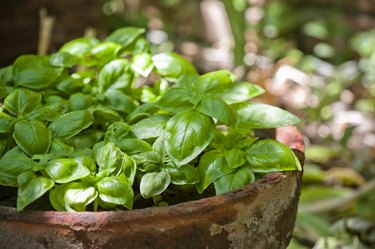
Sweet basil (Ocimum basilicum, USDA zone 10) is arguably the most popular herb that people choose to grow in their home gardens. However, what you may not know is that there are a large variety of basil types. Holy basil (Ocimum tenuiflorum, formerly Ocimum sanctum, zones 10-11) is one of the types that may be less common and differs from sweet basil in many ways. While they remain in the same genus, they represent different species and have different uses and properties that make them unique.
Holy Basil Herb Basics
Video of the Day
The herb holy basil is native to Southeast Asia. What makes this herb so special is that it is used for its many medicinal properties, unlike its common sweet basil relative. It can be consumed in many different ways to reap its benefits.
Video of the Day
The medicinal properties of this plant can be as simple as treating insect bites from its extracted essential oils to more severe illnesses, such as bronchitis, by using the flower of the plant. This herb is reported to be beneficial in boosting your immune system as well as helping with concentration for people with ADD (attention deficit disorder) or ADHD (attention deficit hyperactivity disorder).
Holy Basil's Extra Medicinal Properties
According to the University of New England, the holy basil plant is different from the sweet basil herb because it can help reduce stress and anxiety simply by consuming it. It can help with issues such as depression too as as well as aid in alleviating any allergy symptoms you may be experiencing. Studies have shown that holy basil can also help with blood pressure and can help reduce stress and even help lower cholesterol.
One of the best ways to consume holy basil to obtain its health benefits is in the form of tea. Tear the leaves into pieces and place them in a teapot with boiling water. Let the leaves of the herb steep for approximately seven minutes; then pour the tea into a cup using a strainer, if necessary, to remove all remnants of the leaves. Add sweetener as desired. Then simply sip and enjoy the benefits.
Differences in Taste and Appearance
As all of holy basil's health benefits demonstrate, it is quite different from the well-known sweet basil plant. The sweet basil herb is used mainly as a cooking ingredient to help elevate a meal and give it extra flavor, whereas holy basil is rarely used in the culinary world.
When it comes to appearance, it may be a bit trickier to tell the two types of basil apart, as holy basil is one of the most similar in terms of appearance to sweet basil compared to other basil varieties. One of the first ways to identify a difference between these plants visually is by looking at the stem. The holy basil plant has a hairier stem, and the sweet basil's stem is hairless. The leaves can also help with differentiation because sweet basil has smooth, plump leaves, and holy basil leaves have a more jagged appearance.